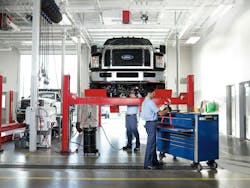At some point in your climb up the managerial ladder, you’ve probably come across a book on continuous improvement, or the Japanese equivalent “kaizen.” You may have even heard of Six Sigma, a strategy all about removing defects in processes, using data, and optimizing outcomes. Invented by Motorola engineer Bill Smith and popularized by General Electric decades ago for manufacturing, it codifies tenets to help any leader. And for sure you’re familiar with Toyota vehicles’ storied reliability, though did you know that’s due to the Toyota Production System, which blends elements of Six Sigma and kaizen to reduce waste and boost quality?
Whether you have a deep or cursory knowledge of the above, what it all simply boils down to is being lean—removing excess, or trimming the fat, if you will. And that’s something all maintenance operations strive for, as maintenance is a thing you have to do, not want to do. If you want to be excessive with customer service or employee incentives, or garishly outfit your trucks with chrome and color, knock yourself out. After all, fat does add flavor. But in the shop, it’s all about sustenance. What is the minimum amount of time and energy you can exert to get the best results? The return on investment must be quantifiable—and worth the effort. And the way to find that out is by integrating a lean mindset into all that you do.
To become a true master of lean, like a Six Sigma Black Belt, it takes years of reading and practice. But you could probably read this lean primer, or refresher, using examples and advice from bona fide efficiency aficionados and some who are just starting out, in about eight minutes. It should be a highly efficient use of your time (and if not, let us know and we’ll find ways to improve ourselves!).
Lean basics
By osmosis, you may already have the basic recipe for effective lean leadership in your head. Many oft-repeated axioms in business are derived from lean principles, such as “fail fast.”
David Julian, CTO and co-founder, Netradyne, a provider of AI dash cams for fleets, offered another, quoting legendary management expert Peter Drucker: “What gets measured gets improved.”
In other words, data is the foundation for continuous improvement.
And both adages are intertwined. To quantify what success looks like for a new initiative, you must set the demarcation line between winning and losing. That’s your benchmark. Ideally, it should be derived from data from both internal and external industry sources. (Plenty of maintenance providers, such as Penske Truck Leasing and Fleet Advantage, offer benchmarking tools.)
Wherever you get it, just remember that without good data, you’re just guessing. Instead of a beautiful lean cut, you’ll wind up with mystery meat.
Let’s say you review your shop numbers and you’ve chosen to improve technician efficiency, a KPI calculated by dividing a tech’s total hours by actual hours billed. You had a hunch it was down and confirmed so using your shop’s historical data. If you have more than one facility, compare this metric amongst them all. You can also check the average for your region by referring to industry reports, such as Fullbay’s State of Heavy-Duty Repair Report. In the latest installment, Fullbay found the Southeast has a 117% tech efficiency rate in 2023, up 15 points from 2022. If your Savannah, Georgia-based shop has a rate of 80%, while the Augusta one is at 115%, that’s a sign you should focus on Savannah.
Those changes would likely also involve measuring and attempting to raise standard repair times. Maybe it’s one or two techs bringing this down, just like a faulty sensor can bring a whole system down. Using lean methodology, you can troubleshoot and find the root cause. If you need help, take a look at American Trucking Associations’ Technology & Maintenance Council Recommended Practice 1606, SRT Implementation Guidelines, and RP 538, Quality Shop Process Improvement. These can help you come up with general ways to raise efficiency and productivity.
“Bite-sized chunks”
To truly achieve lean operations, the KPIs you choose to raise should revolve around ways to make workflows and processes “faster, better, [and] cheaper,” Julian noted.
He learned this firsthand at the start of his career working on efficient communications with space probes at NASA’s Jet Propulsion Labs in the 1990s. JPL at the time was working on the Cassini probe that would journey to Saturn, as well as the Mars rover, and continuous improvement was vital as the scientists simulated the sun’s light output and Mars’ harsh terrain. While these multibillion-dollar projects were going on, there was also a push to spread investments across a relatively cheaper array of $100 million ones, where they would risk more failure but also achieve faster results.
Using the tech efficiency example, you may want to select a handful of measurable ways to improve efficiency.
“Narrow it down and make it bite-sized chunks,” Julian said. “What’s one or two things to work on? Over time, these small steps really add up.”
He likens this to how fleets can reduce accidents, a major expense on the logistics and maintenance sides, with dash cam deployments. Solutions like Netradyne’s detect unsafe driving and provide real-time in-cab coaching.
If a driver acts unsafely, the AI-enabled system immediately lets them know. The older model is waiting for someone at a call center to review a driver running a stop sign after the system identifies an event, alerting the safety manager, and then having them discuss with the driver several days later. That’s not lean.
“By the time the driver’s getting coaching, they don’t remember exactly what’s going on,” Julian said. The system has intricate rubrics and a scoring system of 0-1,000 for tracking good and bad behaviors. For a driver with a 550, using the data, focusing on just a few areas, and quick coaching, Julian said they can jump up to 650, eventually hitting over 900.
By reducing steps and cutting out the middleman, “we’ve seen 30 to 50% reduction in accident rates or more from fleets across the board,” Julian said.
Lean layout
Henry Ford, the father of lean, is credited being the first to truly implement waste-cutting methods like inventory control and standardizing workflows via the moving assembly line, all to ensure the Model-T could be made quickly, efficiently, and affordably. These are all highly pertinent things in the shop, a fact not lost on Ford’s maintenance side.
“At Ford, we honor Henry Ford's lean legacy by embedding efficiency into our daily operations,” said Doug Danstrom, director of service performance at Ford Motor Company, noting lean principles are used across Ford Pro’s Elite Commercial Service Centers to parts delivery and shop layout.
Anyone who’s incurred several days of vehicle downtime due to a lagging part knows how that hurts efficiency. And regarding shop layout, minimizing technician downtime in between working on vehicles ultimately maximizes time spent on service, Danstrom explained.
This includes “expanded service bays, strategically placed equipment and well-defined work zones that minimize unnecessary movement,” Danstrom said. “This thoughtful arrangement not only maximizes speed and flexibility but also enhances overall safety within the bay.”
The work is never truly done, as Ford practices “continuous evaluation and improvement to optimize workflows and reduce downtime,” Danstrom said.
Smarter parts strategy
That lean mentality started by Ford’s founder travels with former employees as well.
“It’s just in everyone’s DNA that works there—everyone’s looking at waste,” explained Harrison Wells, a mechanical engineer who helped design the Ford Windstar and Freestyle. Nowadays, he’s the vice president of professional services at the aptly named LeanDNA, a company that uses software to improve organizations’ supply chains by leveraging their proprietary enterprise resource planning system.
To get started, managers can come up with rules and prioritizations to “filter that noise in the ERP system and make [data] very actionable,” Wells said. The same mentality can also be applied to alerts from fleet and shop management platforms. After all, wasting several minutes a day sorting through irrelevant notifications is akin to a diagnostic tech having to sift through dozens of superfluous fault codes.
Wells also advocates for injecting more analytics and data into your planning software, and having “a plan for every part” to exceed the traditional just-in-time parts model, which showed its flaws during COVID with the numerous shortages that arose.
“People are putting a lot more thought into it,” Wells said. But to take advantage of this strategy, this means examining inventory service levels in relation to stocking. The percentage represents the likelihood you will be able to meet demand and avoid an out-of-stock situation that would ultimately lead to more vehicle downtime for your customers.
To help, LeanDNA uses a system based on the standard deviation of failures, and can recommend minimum stocking levels to hit a specific service level, Wells stated.
“Let’s say it’s a relatively expensive, steady part—you don’t want to strand somebody, so you might have a higher service level,” he explained, adding shops may want to keep critical parts with higher failure rates at 98%, while less critical, more reliable ones could be at 85%.
In general, now is a boom time for developing new lean practices, especially due to the implementation of large language models and analytics algorithms, all of which can provide shops with the information they need to improve their operations.
“It’s lean on steroids—you can perform the analysis so quickly,” Wells said of how advanced “AI” technology is pushing efficiency forward. “Basically, you can start pointing large language models at your ERP system and your data, and you can tease out information, and it’s surprisingly easy.”
This allows you to “use data to pivot quickly,” he said.
That’s not as lean a phrase as “fail fast,” but as shops become more sophisticated with less room for wasted efforts, it’ll do.
But let’s close with one final morsel from the place where lean all started: Ford.
“Lean is a journey, not a destination,” Danstrom offered. “Continuously seek improvement, even when performing well. The goal is to create a culture of continuous improvement, empowering everyone to enhance customer value. As Henry Ford showed, relentless efficiency and innovation drive remarkable results."
About the Author

John Hitch
Editor-in-chief, Fleet Maintenance
John Hitch is the award-winning editor-in-chief of Fleet Maintenance, where his mission is to provide maintenance leaders and technicians with the the latest information on tools, strategies, and best practices to keep their fleets' commercial vehicles moving.
He is based out of Cleveland, Ohio, and has worked in the B2B journalism space for more than a decade. Hitch was previously senior editor for FleetOwner and before that was technology editor for IndustryWeek and and managing editor of New Equipment Digest.
Hitch graduated from Kent State University and was editor of the student magazine The Burr in 2009.
The former sonar technician served honorably aboard the fast-attack submarine USS Oklahoma City (SSN-723), where he participated in counter-drug ops, an under-ice expedition, and other missions he's not allowed to talk about for several more decades.


